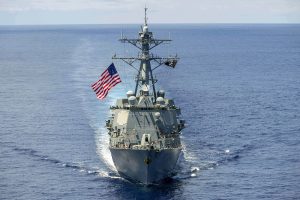Nearly two weeks after the first U.S. freedom of navigation operation near a Chinese artificial island in the South China Sea, tensions remain high. On Saturday, speaking on opposite ends of the Pacific Ocean, Chinese President Xi Jinping and U.S. Defense Secretary Ashton Carter delivered parallel remarks on the South China Sea that highlighted the rift between the U.S. and Chinese positions on the issue.
Xi, in Singapore for a historic meeting with his counterpart across the Taiwan Strait, Ma Ying-jeou, delivered remarks at the National University of Singapore where he described China’s position that the “islands in the South China Sea have been China’s territory since ancient times.” Xi added that the “Chinese government must take responsibility to safeguard its territorial sovereignty and legitimate maritime interests.”
“Some people have been hyping China’s threat,” Xi continued. “This is either due to the ignorance of Chinese history, culture and current policy, or out of some misunderstanding and prejudice, and probably for some ulterior reasons.”
Though Xi’s language was in line with statements on the South China Sea by the Chinese foreign and defense ministers, the optics of the Chinese president himself making these declarations in Singapore, a hub for Southeast Asian commercial maritime activity, emphasized the extent to which China is interested in publicly clarifying its position on the South China Sea after the U.S. Navy has started undertaking freedom of navigation patrols.
Meanwhile, across the Pacific, at the Ronald Reagan Presidential Library in California, the U.S. defense secretary spoke at length on the United States’ plans for the South China Sea. The Obama administration has been reluctant to speak publicly on the specifics of the mission carried out in the Spratly Islands by the USS Lassen, the guided-missile destroyer that transited within 12 nautical miles of Subi Reef compliant with the international legal requirements for “innocent passage.”
While Carter did not offer new details on the operation itself, he emphasized that the United States would continue its freedom of navigation operations in the South China Sea. “We’ve done them before, all over the world,” Carter said. “And we will do them again.” The defense secretary provided no specific timeline, but earlier reports have suggested that the United States is planning on carrying out two of these missions per quarter.
“How China behaves will be the true test of its commitment to peace and security,” Carter added. “This is why nations across the region are watching China’s actions in areas like the maritime domain and cyberspace.”
“The United States joins virtually everyone else in the region in being deeply concerned about the pace and scope of land reclamation in the South China Sea,” Carter continued, emphasizing China’s regional isolation on the issue of the South China Sea.
With the U.S. Navy’s plans to regularly challenge excessive Chinese maritime claims in the South China Sea, tensions between the U.S. and China will remain high. Though the first freedom of navigation showdown resulted in a moderate Chinese response, it is unclear if Beijing will abide repeated U.S. Navy operations with the same restraint.

































